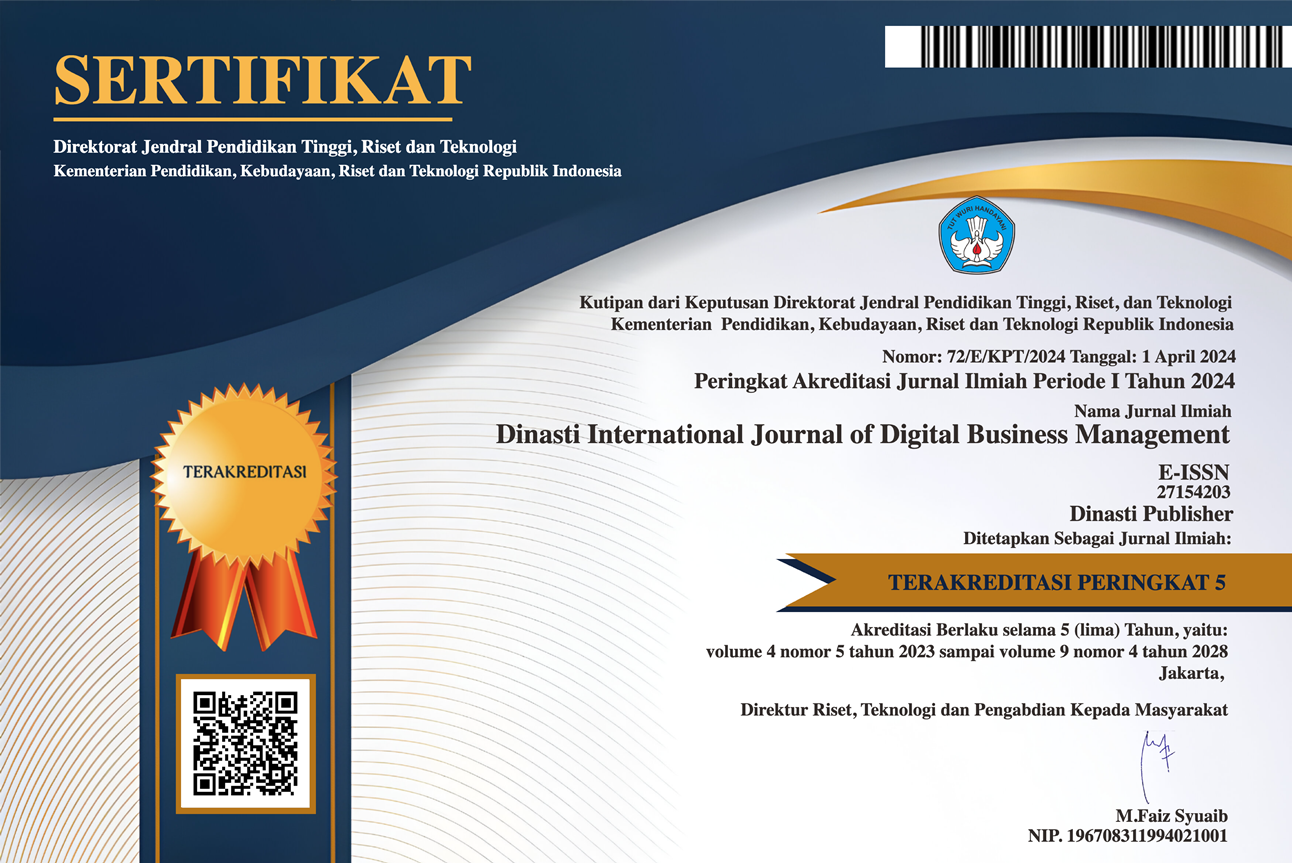The Influence of Leader Member Exchange Quality on Employee Performance through Intention to Quit Work
DOI:
https://doi.org/10.31933/dijdbm.v5i2.2255Keywords:
Leader Member Exchange, Employee Performance, Intention to Quit WorkAbstract
The focus of this research is on PT Permodalan Nasional Madani Pekanbaru Branch Office, using independent variables consisting ofleader member exchange (LMX), the dependent variable is employee performance, and the intervening variable is the employee's intention to quit work. This research aims to analyze how big the influence of relationship quality isleader member exchange (LMX) on employee performance at PT Permodalan Nasional Madani Pekanbaru Branch Office with intention to quit work as an intervening variable. The sample consisted of 100 employees of AO PT Permodalan Nasional Madani Pekanbaru Branch Office and all employees were taken as samples using the census method. Research data was analyzed using the SmartPLS series 4 application. The data analyzed came from questionnaires distributed to all employees sampled in this research. Based on the research results, it can be concluded that the better the quality of LMX, the better the performance of employees at PT Permodalan Nasional Madani (PT PNM) Pekanbaru branch office. LMX quality does not significantly influence employee performance through intention to quit work as an intervening variable at PT Permodalan Nasional Madani (PT PNM) Pekanbaru branch office.
References
Abdillah, F. (2012). The Relationship between Group Cohesiveness and IntentionTurnoveron Employees.Journal of Social and Industrial Psychology. Downloaded from http://journal.unnes.ac.id/sju/index.php/sip.
Collins, J. B., J. B. Carla, dan D. M. Meyer. (2007). Gender differences in the impact of leadership style on subordinate embeddedness and job satisfaction. Science Direct, The Leadership Quarterly Elsevier, 25(1): 660-671.
Ghozali, Imam. (2011).Multivariate Analysis Application with SPSS Program. Semarang. Diponegoro University Publishing Agency.
Haris, K. J. dan K. M. Kacmar. (2004). The mediating role of organizational job embeddedness in the LMX-Outcomes relationship, Science Direct, The Leadership Quarterly Elsevier, 22(1): 271–281.
Hasibuan, Malayu S.P. (2018). Human Resource Management. Jakarta: PT Bumi Aksara.
Indrawati, A. D. 2005. The Influence of Job Satisfaction on Employee Performance and Customer Satisfaction at Private Hospitals in Denpasar City. Journal of Management, Business Strategy and Entrepreneurship, 7(2): 135-142.
Kambu, A., E. A. Troena, Surachman, and M. Setiawan. (2012). The Influence of LeaderMember Exchange, Perceptions of ORGANIZATIONAL Support, Papuan Ethnic Culture and Organizational Citizenship Behavior, on Employee Performance at the Regional Secretary of Papua Province. Journal of Management Applications, 10(2).
Manurung, R. M. (2018). The influence of leader member exchange on turnover intention with job satisfaction as a mediating variable (study on employees of PT Bina Busana Internusa Semarang. Thesis. Unnes.
Othman Rozhan, Foo Fang Ee, dan Ng Lay Shi. (2009). Understanding dysfunctional leadermember exchange: antecedents and outcomes. Leadership & Organization Development Journal, Flight. 31, No. 4.
Paripurna, S. and Subudi. (2017). The Influence of Leadership and Job Satisfaction on Turnover Intention and its Impact on Employee Performance at Pt Agung Automall Kuta. Udayana University Economics and Business E-Journal, 6 (6): 2441-2474.
Rousseau, D. M. (1989). Psychological and Implied Contracts in Organizations. Employee Responsibilities and Rights Journal, 8(1).
Shaufeli.W.B., Salanova, M., Gonzalez, R. V. and Bakker, A.B. (2002). “The measurement of engagementand burnout: a two sample confirmatory factor anlytic approach”. Journal of Happiness Studies, 1(2):10-15.
Widjaja et al., 2006. Perception AnalysisEmployee Empowerment ToEmployee Turnover Intention At Hotel X, Kupang, Nusa Tenggara. Journal of Hospitality Management, Vol. 4, no. 2, September 2008: 72-84.
Downloads
Published
Issue
Section
License
Copyright (c) 2024 Hendra Jalius, Agus Salim

This work is licensed under a Creative Commons Attribution 4.0 International License.
Authors who publish their manuscripts in this journal agree to the following conditions:
- The copyright on each article belongs to the author(s).
- The author acknowledges that the Dinasti International Journal of Digital Business Management (DIJDBM) has the right to be the first to publish with a Creative Commons Attribution 4.0 International license (Attribution 4.0 International (CC BY 4.0).
- Authors can submit articles separately, arrange for the non-exclusive distribution of manuscripts that have been published in this journal into other versions (e.g., sent to the author's institutional repository, publication into books, etc.), by acknowledging that the manuscript has been published for the first time in the Dinasti International Journal of Digital Business Management (DIJDBM).















































